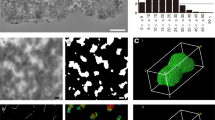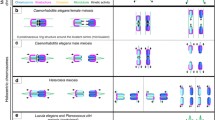Abstract
Electron microscopy of unstained BrdU-substituted chromosomes treated with 1.0 M NaH2PO4 at high pH and high temperature has demonstrated that there is a structural basis for the light microscopic observation of differentially Giemsa-stained unifilarly and bifilarly BrdU-substituted chromatids and the appearance of chromosome dots. At progressively higher treatment temperatures, sequential structural changes occurred in the chromosomes. After treatment with NaH2PO4 at 70–80° C, unifilarly BrdU-substituted chromatids were much more electron opaque than bifilarly substituted chromatids, and the overall data suggest that this difference in electron opacity is a result of the preferential extraction of chromosomal DNA from the bifilarly BrdU-substituted chromatids. NaH2PO4 treatment of the BrdU-substituted chromosomes at 80–90° ° C resulted in the formation of highly electron opaque spots (dots) on one or both chromatids. Dots first appeared on the electron lucent bifilarly BrdU-substituted chromatid, indicating that the chromatin with the greatest substitution of BrdU in its DNA is most susceptible to dot formation. At a slightly higher temperature, dots also appeared on the unifilarly BrdU-substituted chromatid concomitant with a disappearance of the electron opacity characterizing this chromatid at the lower treatment temperature. The dots may be formed by an extreme reorganization of residual chromatin or by some kind of interaction or reaction between the chromatin and the salts in the incubation medium. G-band regions may serve as focal points for dot formation.
Similar content being viewed by others
References
Burkholder, G.D.: Electron microscopic visualization of chromosomes banded with trypsin. Nature (Lond.) 247, 292–294 (1974)
Burkholder, G.D.: The ultrastructure of G- and C-banded chromosomes. Exp. Cell Res. 90, 269–278 (1975)
Burkholder, G.D.: Electron microscopy of banded mammalian chromosomes. In: Principles and techniques of electron microscopy. Biological applications (M.A. Hayat, ed.), vol. 7, pp. 323–340. New York: Van Nostrand Reinhold Company 1977
Goto, K., Akematsu, T., Shimazu, H., Sugiyama, T.: Simple differential Giemsa staining of sister chromatids after treatment with photosensitive dyes and exposure to light and the mechanism of staining. Chromosoma (Berl.) 53, 223–230 (1975)
Korenberg, J.R., Freedlender, E.F.: Giemsa technique for the detection of sister chromatid exchanges. Chromosoma (Berl.) 48, 355–360 (1974)
Latt, S.A.: Microfluorometric detection of deoxyribonucleic acid replication in human metaphase chromosomes. Proc. nat. Acad. Sci. (Wash.) 70, 3395–3399 (1973)
Latt, S.A.: Optical studies of metaphase chromosome organization. Ann. Rev. Biophys. Bioeng. 5, 1–37 (1976)
Perry, P, Wolff, S.: New Giemsa method for the differential staining of sister chromatids. Nature (Lond.) 251, 156–158 (1974)
Scheid, W.: Mechanism of differential staining of BUdR-substituted Vicia faba chromosomes. Exp. Cell Res. 101, 55–58 (1976)
Scheid, W., Traupe, H.: Further studies on the mechanism involved in differential staining of BUdR-substituted Vicia faba chromosomes. Exp. Cell Res. 108, 440–444 (1977)
Sugiyama, T., Goto, K., Kano, Y.: Mechanism of differential Giemsa method for sister chromatids. Nature (Lond.) 259, 59–60 (1976)
Wang, H.C., Mukerji, S.: Dotted chromosomes produced in sodium phosphate solution supersaturated with NaHCO3. Chromosoma (Berl.) 58, 263–267 (1976)
Author information
Authors and Affiliations
Rights and permissions
About this article
Cite this article
Burkholder, G.D., Wang, H.C. Electron microscopy of differentially BrdU-substituted sister chromatids treated with sodium phosphate. Chromosoma 70, 101–107 (1978). https://doi.org/10.1007/BF00292219
Received:
Accepted:
Issue Date:
DOI: https://doi.org/10.1007/BF00292219




